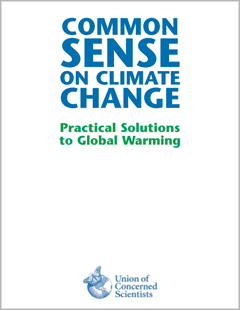Mark Twain might as well have been talking about global warming when he famously remarked, "Everybody talks about the weather, but nobody ever does anything about it." For years we have heard so much about the causes of climate change, that we’ve missed the fact that there are simple, practical solutions that can slow this growing problem. Technologies exist today that can cut emissions of heat-trapping gases and make a real difference in the health of our planet. And these solutions will be good for our economy, reduce our dependence on foreign oil, and enhance our energy security.
A challenge we can meet
Global warming doesn’t just mean balmy February days in northern climes. It also means increasingly hot days in the summer, and a host of negative impacts that are already under way and are expected to intensify in the coming decades.
- More heat waves will likely increase the risk of heat-related illnesses and deaths.
- Cities and towns along the nation's major rivers will experience more severe and frequent flooding.
- Some areas will likely experience more extensive and prolonged droughts.
- Some of our favorite coastal and low-lying vacation areas, such as parts of the Florida Keys and Cape Cod, will be much less appealing as sea levels rise, dunes erode, and the areas become more vulnerable to coastal storms.
- Many families and businesses, who have made their living from fishing, farming, and tourism could lose their livelihoods, and others who love hunting, boating, skiing, birdwatching, and just relaxing near lakes, streams, and wetlands will see some of their favorite places irretrievably changed.
The solutions to climate change are here and it's time we put them to use. If we get started today we can tackle this problem and decrease the unpleasant outcomes that await us if we do nothing. The steps we need to take are common sense. And, more often than not, they will save consumers money. The cost of inaction, however, is unacceptably high.
Act now
The scientific consensus is in. Our planet is warming, and we are helping make it happen by adding more heat-trapping gases, primarily carbon dioxide (CO2), to the atmosphere. The burning of fossil fuel (oil, coal, and natural gas) alone accounts for about 75 percent of annual CO2 emissions from human activities. Deforestation—the cutting and burning of forests that trap and store carbon—accounts for about another 20 percent.
Procrastination is not an option. Scientists agree that if we wait 10, 20, or 50 years, the problem will be much more difficult to address and the consequences for us will be that much more serious.
We're treating our atmosphere like we once did our rivers. We used to dump waste thoughtlessly into our waterways, believing that they were infinite in their capacity to hold rubbish. But when entire fisheries were poisoned and rivers began to catch fire, we realized what a horrible mistake that was.
Our atmosphere has limits too. CO2 remains in the atmosphere for about 100 years. The longer we keep polluting, the longer it will take to recover and the more irreversible damage will be done.
Common sense solutions
Fuel-efficient vehicles. Renewable energy. Protecting threatened forests. These common sense solutions won't only reduce global warming, many will save us money and create new business opportunities.
Best of all, these solutions exist now. We just need to insist that business and government take the necessary steps to make them available and affordable. Then we have to let consumers know what to do and provide incentives to help all of us make better choices.
The following five sensible steps are available today and can have an enormous impact on the problem CO2 remains in the atmosphere for about 100 years.




